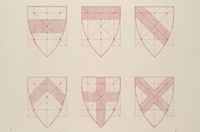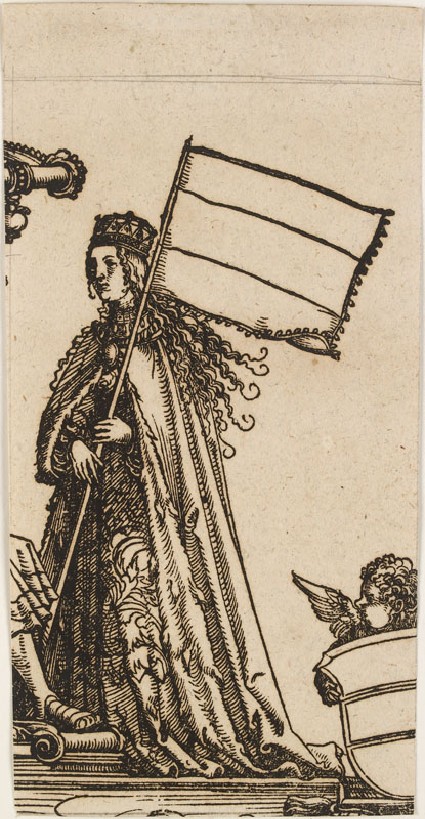Ruskin's revision to the Rudimentary series (1878)
Unpublished manuscript catalogue for proposed re-organisation of the Rudimentary series.

Ruskin's Catalogues: 1 object
Show search help- Reference URL
Actions
A Woman holding a Banner (cut from a Plate in "The Triumph of Maximilian") Mathias André Schmidt
-
Ruskin text
Portions of the Woodcuts by Hans Burgmair , representing the Triumph of Maximilian I . These woodcuts, and the smaller ones in the First Cabinet, are entirely perfect examples of execution with the pure black line, and I have given them in this quantity, that the students may always find one or other to work from. Only small pieces of them are to be attempted, generally at the student's choice. He should begin with any of the shields in R|15 to R|21, and advance to the Burgmair s; but one or other of the single figures, R|26 and R|27, is to be completely drawn eventually by every member of my class. They are to be photographed, in order that every student may have his own, to work from at home. -
Details
- Artist/maker
-
Mathias André Schmidt (active c. 1796) (printer)Anonymous (German) (Anonymous, German) (block cutter)
- Object type
- Material and technique
- woodcut on paper
- Dimensions
- 170 x 86 mm (sheet)
- Inscription
- Verso, top centre, the Ruskin School's stamp
- Provenance
-
Presented by John Ruskin to the Ruskin Drawing School (University of Oxford), 1875; transferred from the Ruskin Drawing School to the Ashmolean Museum, c.1949.
- No. of items
- 1
- Accession no.
- WA.RS.RUD.026
-
Subject terms allocated by curators:
Subjects
-
References in which this object is cited include:
References
Ruskin, John, Instructions in Practice of Elementary Drawing, Arranged with Reference to the First Series of Examples in the Drawings Schools of the University of Oxford (n.p., [1872]), cat. Rudimentary no. 26
Ruskin, John, Instructions in the Preliminary Exercises Arranged for the Lower Drawing-School (London: Smith, Elder, 1872), cat. Rudimentary no. 26
Ruskin, John, Instructions in the Preliminary Exercise Arranged For the Lower Drawing-School (London: Spottiswoode, 1873), cat. Rudimentary no. 26
Ruskin, John, ‘Rudimentary Series 1878’, 1878, Oxford, Oxford University Archives, cat. Rudimentary no. 26
Ruskin, John, ‘The Ruskin Art Collection at Oxford: Catalogues, Notes and Instructions’, Edward T. Cook and Alexander Wedderburn, eds, The Works of John Ruskin: Library Edition, 39 (London: George Allen, 1903-1912), 21, cat. Rudimentary no. 26
Location
-
- Western Art Print Room
Position in Ruskin’s Collection
Ruskin's Catalogues
-
Ruskin's Rudimentary series, 3rd ed. (1872)
Portions of the Woodcuts by Hans Burgmair , representing the Triumph of Maximilian I . These woodcuts, and the smaller ones in the First Cabinet, are entirely perfect examples of execution with the pure black line, and I have given them in this quantity, that the students may always find one or other to work from. Only small pieces of them are to be attempted, generally at the student's choice. He should begin with any of the shields in R|15 to R|21, and advance to the Burgmair s; but one or other of the single figures, R|26 and R|27, is to be completely drawn eventually by every member of my class. They are to be photographed, in order that every student may have his own, to work from at home. -
Ruskin's Rudimentary series 4th ed. (1872)
Portions of the Woodcuts by Hans Burgkmair , representing the Triumph of Maximilian I . These woodcuts, and the smaller ones in the First Cabinet, are entirely perfect examples of execution with the pure black line, and I have given them in this quantity, that the students may always find one or other to work from. Only small pieces of them are to be attempted, generally at the student's choice. He should begin with any of the shields in R|15 to R|21, and advance to the Burgkmair s; but one or other of the single figures, R|26 and R|27, is to be completely drawn eventually by every member of my class. They are to be photographed, in order that every student may have his own, to work from at home. -
Ruskin's Rudimentary series, 5th ed. (1873)
Portions of the Woodcuts by Hans Burgkmair , representing the Triumph of Maximilian I . These woodcuts, and the smaller ones in the First Cabinet, are entirely perfect examples of execution with the pure black line, and I have given them in this quantity, that the students may always find one or other to work from. Only small pieces of them are to be attempted, generally at the student's choice. He should begin with any of the shields in R|15 to R|21, and advance to the Burgkmair s; but one or other of the single figures, R|26 and R|27, is to be completely drawn eventually by every member of my class. They are to be photographed, in order that every student may have his own, to work from at home. -
Ruskin's revision to the Rudimentary series (1878)
26-38 remain 26.Extremely beautiful, and at one time or other, at M.r. Macdonald’s discretion, to be copied by all students.





